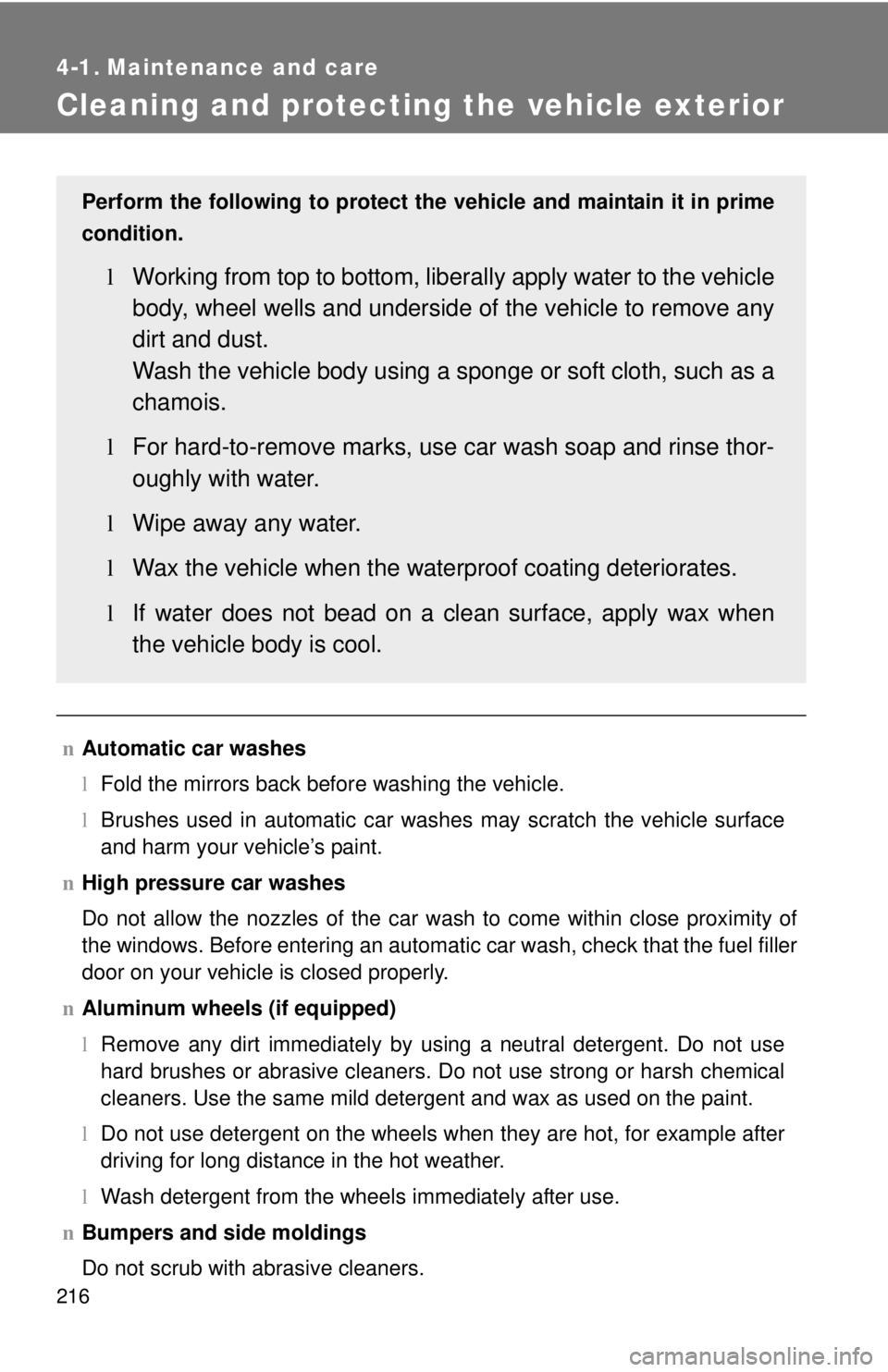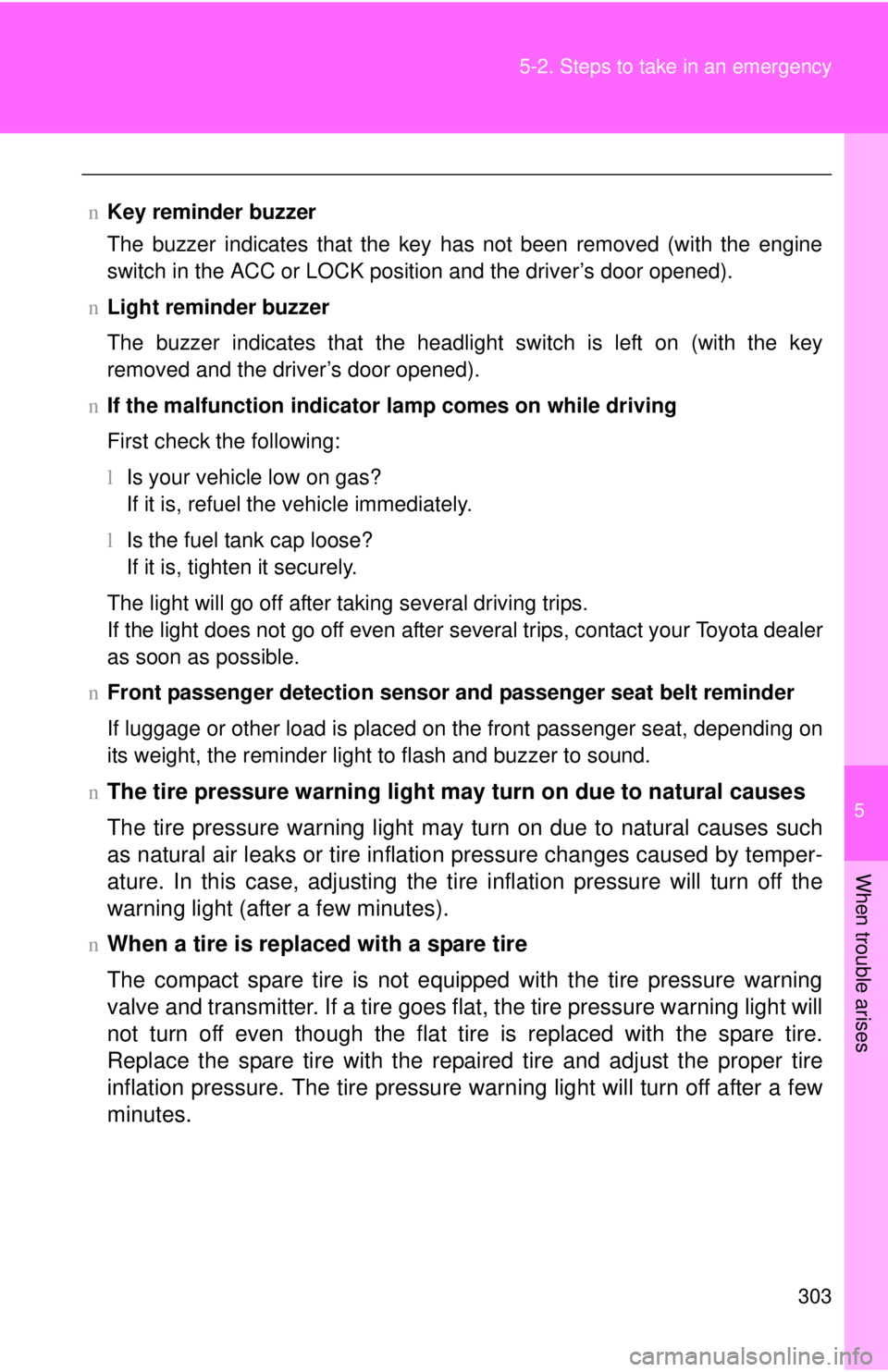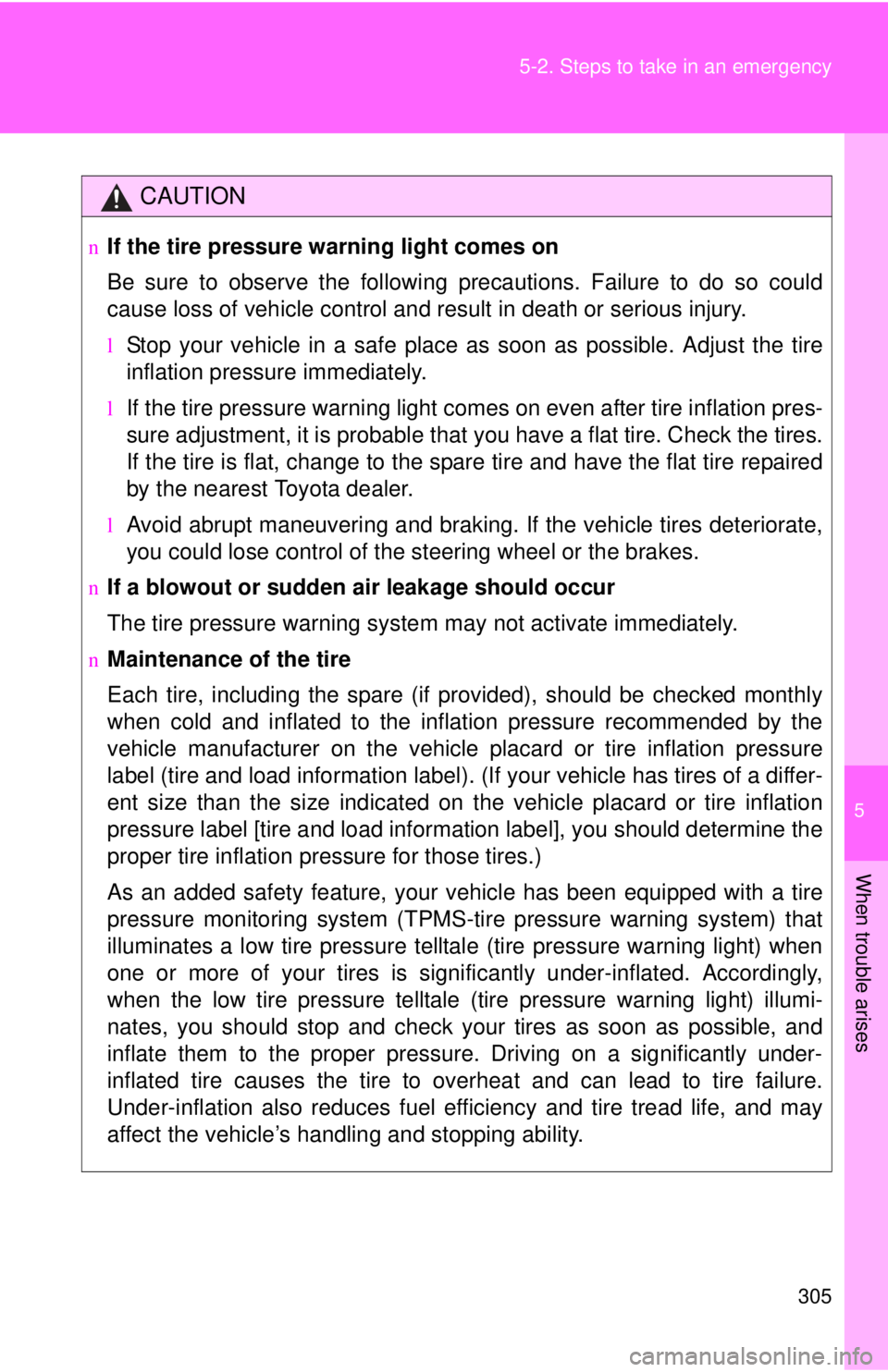Page 3 of 386
1
OVERVIEW
FEATURES/OPERATIONS
SAFETY AND EMERGENCY FEATURES
Engine maintenance7Fuel tank door release and cap 6Hood release 7Indicator symbols4-5Instrument cluster 4Instrument panel2-3Keyless entry16
Light control-Instrument panel 6
Air Conditioning/Heating13Audio12-13Automatic Transmission 8Bottle holders-Front seat15Clock 15Cruise control14Cup holders15Lights & turn signals11Parking brake 9Power outlet13Seat adjustments-Front 9Seat adjustments-Rear10Seats-Head restraints10Tilt steering wheel 8Trunk release 8VSC OFF button14Windows-Power 9
Windshield wipers & washers10
Door locks-Power 16Doors-Child safety locks16Seatbelts16Seatbelts-Shoulder belt anchor17Spare tire & tools 17Trunk-Internal release17
Tire Pressure Monitoring (warning) System 16
OVERVIEW
FEATURES/OPERATIONS
SAFETY AND
EMERGENCY FEATURES
INDEX
1Visit your Toyota dealer for information on this and other customizable options.
Page 7 of 386
5
OVERVIEW
FEATURES/OPERATIONS
SAFETY AND EMERGENCY FEATURES
Low engine oil pressure warning1
Anti-lock Brake System warning1
Malfunction/Check Engine indicator1
3If this light flashes, refer to “Cruise control,” Section 2-4, 2010 Owner’s Manual.
Open door warning
Low windshield washer fluid level warning
Engine oil replacement reminder
1
AIR BAG ON indicator
AIR BAG OFF indicator
Headlight low beam indicator
Turn signal indicator
High engine coolant temperature warning1
Low engine coolant temperature indicator2
Headlight high beam indicator
Cruise control indicator
3
Front fog light indicator Airbag SRS warning
1
Low fuel level warning Electric power steering system warning
1
Low Tire Pressure Warning1
Cruise control SET indicator
Slip indicator1
Vehicle Stability Control OFF indicator1
Traction Control OFF indicator
Page 27 of 386
7
Tires
lRotation
l Replacement
l Inflation pressure
l Information
P. 246
P. 307
P. 252
P. 346
∗: If equipped
Trunk P. 33Doors P. 28
Fuel filler door P. 58
Rear turn signal lights P. 117
Rear window defogger∗ P. 170
License plate lights P. 130
Stop/tail and rear side
marker lights
P. 130
Page 227 of 386

216
4-1. Maintenance and care
Cleaning and protecting the vehicle exterior
nAutomatic car washes
lFold the mirrors back before washing the vehicle.
l Brushes used in automatic car washes may scratch the vehicle surface
and harm your vehicle’s paint.
n High pressure car washes
Do not allow the nozzles of the car wash to come within close proximity \
of
the windows. Before entering an automatic car wash, check that the fuel filler
door on your vehicle is closed properly.
n Aluminum wheels (if equipped)
lRemove any dirt immediately by using a neutral detergent. Do not use
hard brushes or abrasive cleaners. Do not use strong or harsh chemical
cleaners. Use the same mild detergent and wax as used on the paint.
l Do not use detergent on the wheels when they are hot, for example after
driving for long distance in the hot weather.
l Wash detergent from the wheels immediately after use.
n Bumpers and side moldings
Do not scrub with abrasive cleaners.
Perform the following to protect the vehicle and maintain it in prime
condition.
l Working from top to bottom, liber ally apply water to the vehicle
body, wheel wells and underside of the vehicle to remove any
dirt and dust.
Wash the vehicle body using a sponge or soft cloth, such as a
chamois.
l For hard-to-remove marks, use car wash soap and rinse thor-
oughly with water.
l Wipe away any water.
l Wax the vehicle when the waterproof coating deteriorates.
l If water does not bead on a clean surface, apply wax when
the vehicle body is cool.
Page 265 of 386

254 4-3. Do-it-yourself maintenance
nTire inflation pressure check interval
You should check tire pressure every two weeks, or at least once a
month.
Do not forget to check the spare tire.
nEffects of incorrect tire inflation pressure
Driving with incorrect tire inflation pressure ma y result in the following:
lReduced fuel efficiency
lReduced driving comfort and tire life
lReduced safety
lDamage to the drive train
If a tire needs frequent re filling, have it checked by your Toyota dealer.
nInstructions for checking tire inflation pressure
When checking tire inflation pressure, observe the following:
lCheck only when the tires are cold.
If your vehicle has been parked for at least 3 hours and has not been
driven for more than 1 mile or 1.5 km, you will get an accurate cold
tire inflation pressure reading.
lAlways use a tire pressure gauge.
The appearance of the tire can be mi sleading. In addition, tire infla-
tion pressures that are even just a few pounds off can degrade ride
and handling.
lDo not bleed or reduce tire inflation pressure after driving. It is normal
for the tire inflation pressure to be higher after driving.
lNever exceed the vehicle capacity weight.
Passengers and luggage weight should be placed so that the vehicle
is balanced.
Page 313 of 386

5
When trouble arises
303
5-2. Steps to take in an emergency
n
Key reminder buzzer
The buzzer indicates that the key has not been removed (with the engine
switch in the ACC or LOCK position and the driver’s door opened).
n Light reminder buzzer
The buzzer indicates that the headlight switch is left on (with the key
removed and the driver’s door opened).
n If the malfunction indicator lamp comes on while driving
First check the following:
l Is your vehicle low on gas?
If it is, refuel the vehicle immediately.
l Is the fuel tank cap loose?
If it is, tighten it securely.
The light will go off after taking several driving trips.
If the light does not go off even after several trips, contact your Toyota dealer
as soon as possible.
n Front passenger detection sensor and passenger seat belt reminder
If luggage or other load is placed on the front passenger seat, depending on
its weight, the reminder light to flash and buzzer to sound.
n
The tire pressure warning light may turn on due to natural causes
The tire pressure warning light may turn on due to natural causes such
as natural air leaks or tire inflation pressure changes caused by temper-
ature. In this case, adjusting the ti re inflation pressure will turn off the
warning light (after a few minutes).
nWhen a tire is replaced with a spare tire
The compact spare tire is not equipped with the tire pressure warning
valve and transmitter. If a tire goes flat, the tire pressure warning light will
not turn off even though the flat tire is replaced with the spare tire.
Replace the spare tire with the repair ed tire and adjust the proper tire
inflation pressure. The ti re pressure warning light will turn off after a few
minutes.
Page 315 of 386

5
When trouble arises
305
5-2. Steps to take in an emergency
CAUTION
nIf the tire pressure warning light comes on
Be sure to observe the following precautions. Failure to do so could
cause loss of vehicle control and result in death or serious injury.
lStop your vehicle in a safe place as
soon as possible. Adjust the tire
inflation pressure immediately.
lIf the tire pressure warning light comes on even after tire inflation pres-
sure adjustment, it is pr obable that you have a flat tire. Check the tires.
If the tire is flat, change to the spare tire and have the flat tire repaired
by the nearest Toyota dealer.
lAvoid abrupt maneuvering and braking. If the vehicle tires deteriorate,
you could lose control of the steering wheel or the brakes.
nIf a blowout or sudden air leakage should occur
The tire pressure warning syste m may not activate immediately.
nMaintenance of the tire
Each tire, including the spare (if provided), should be checked monthly
when cold and inflated to the inflation pressure recommended by the
vehicle manufacturer on the vehicle placard or tire inflation pressure
label (tire and load information label). (If your vehicle has tires of a differ-
ent size than the size indicated on the vehicle placard or tire inflation
pressure label [tire and load information label], you should determine the
proper tire inflation pr essure for those tires.)
As an added safety feature, your vehicle has been equipped with a tire
pressure monitoring system (TPMS-ti re pressure warning system) that
illuminates a low tire pressure telltal e (tire pressure warning light) when
one or more of your tires is significantly under-inflated. Accordingly,
when the low tire pressure telltale (tire pre ssure warning light) illumi-
nates, you should stop and check your tires as soon as possible, and
inflate them to the proper pressure. Driving on a significantly under-
inflated tire causes the tire to overheat and can lead to tire failure.
Under-inflation also reduces fuel effi ciency and tire tread life, and may
affect the vehicle’s handling and stopping ability.
Page 319 of 386
5
When trouble arises
309
5-2. Steps to take in an emergency
n
Compact spare tire
The compact spare tire saves space in your luggage compartment,
and its lighter weight helps to enhance fuel economy and permits
easier installation in case of a flat tire.
The compact spare tire is
designed for temporary emer-
gency use only.
The compact spare tire is identi-
fied by the distinctive wording
“TEMPORARY USE ONLY”
molded into the sidewall of the
tire.
nWhen using the compact spare tire
As the compact spare tire is not equipped with the tire pressure warning
valve and transmitter, low inflation pr essure of the compact spare tire will
not be warned. Also, if you replace the compact spare tire after the tire
pressure warning light comes on, the light remains on.
nCheck the tire inflation pressure of the compact spare tire.
( → P. 341)